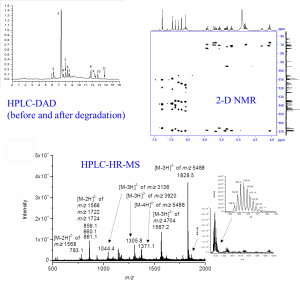Tannin analysis by methods of analytical organic chemistry is one of our key areas of research and we constantly aim to bring new developments into this demanding sector of tannin chemistry
 The analysis of the tannin composition of plant samples is sometimes considered almost an impossible task. However, many of the tannins present in plant cells are such that they can be analysed individually by modern phytochemical methods. This is true for all the galloylglucoses and gallotannins and for most of the ellagitannins. If these are the main secondary metabolites present in a plant, then HPLC-DAD or UPLC-DAD is a sufficient tool for their quantification. But if they are minor constituents and overlapped by other major constituents, then detection power needs to be increased by the utilization of LC-MS instruments. In this case extra care needs to be taken so that it is exactly known what is quantified and what types of standards are used for quantification. The practical use of LC-DAD instruments is at least one order of magnitude more simplified than the use of LC-MS.
The analysis of the tannin composition of plant samples is sometimes considered almost an impossible task. However, many of the tannins present in plant cells are such that they can be analysed individually by modern phytochemical methods. This is true for all the galloylglucoses and gallotannins and for most of the ellagitannins. If these are the main secondary metabolites present in a plant, then HPLC-DAD or UPLC-DAD is a sufficient tool for their quantification. But if they are minor constituents and overlapped by other major constituents, then detection power needs to be increased by the utilization of LC-MS instruments. In this case extra care needs to be taken so that it is exactly known what is quantified and what types of standards are used for quantification. The practical use of LC-DAD instruments is at least one order of magnitude more simplified than the use of LC-MS.
For proanthocyanidins and some oligo- or polymeric ellagitannins, the quantification gets trickier. Some of the smallest proanthocyanidins can be quantified individually, but typically the bulk of the proanthocyanidin pool of a plant cell is represented by polymers. There have not been too many methods for the separate quantification of different sizes of proanthocyanidins, but recently the developments in chromatographic methods together with new inventions in mass spectrometric tools are opening fully new avenues also for accurate proanthocyanidin analysis.
For further details, please have a look at sections Qualitative Analysis of Polyphenols or Quantitative Analysis of Plants. They both dig deeper in tannin analysis.
